What Is A Cutting Mat: Your Guide To Types, Uses And Perfect Cuts
A cutting mat is a must-have. It saves your table from damage. It helps your cutting blades stay sharp longer. It makes your cuts neater and more exact. It can even help you work more safely. It makes crafting easier, better, and more fun. Let’s look at these benefits more closely.
1. Introduction: what exactly is a cutting mat?
A cutting mat is a special flat board or surface. Crafters and hobbyists use it when cutting materials. Think of it like a shield for your table or desk. It is designed to be cut on, unlike a regular table. This tool is very common. It is important for many creative people and many types of projects.
Its main job is to protect your work surface and help you cut. First, the cutting mat protects your table. Sharp tools like craft knives or rotary cutters (a cutting tool with a circular blade that rotates) can damage tables. The mat takes this damage instead. Second, it helps you cut more accurately and easily. Many mats have printed lines or grids. These lines help you make straight cuts. They also help you measure your pieces correctly.
Many different people find cutting mats very useful. People who sew clothes or make quilts use them. People who enjoy paper crafts like making cards or scrapbooking also use them. Model builders, graphic designers, architects, and art students use them. Anyone who likes Do-It-Yourself (DIY) projects also uses them often. It’s a handy tool for many hobbies, school projects, and even some professional jobs.
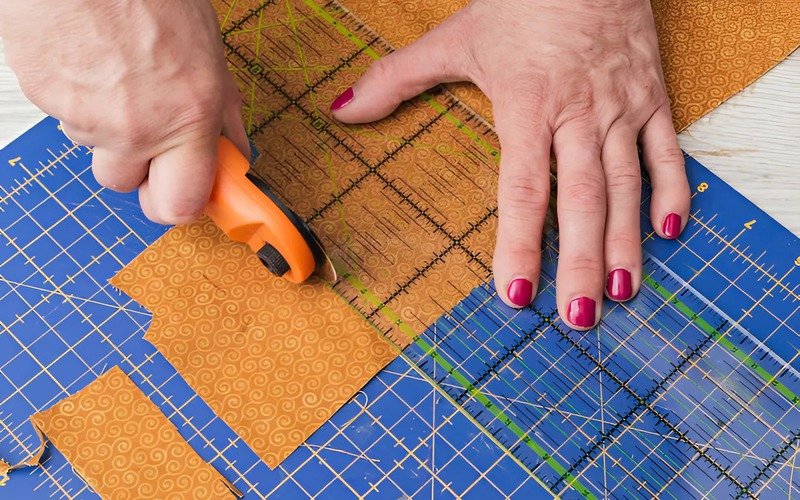
2. Why do you need a cutting mat? the big benefits
Sharp tools like craft knives (a sharp pointed blade in a pen-like handle for precision cutting), X-Acto knives, or rotary cutters can easily leave deep cuts. They can make ugly scratches on your nice tables, desks, or countertops. A cutting mat acts as a protective barrier. It takes all these cuts and marks instead of your furniture.
This allows you to relax and focus on your creative project without worrying about damaging your work surface. At Packlove, we believe a clean, undamaged workspace is professional. It is like how good packaging presents a product professionally.
If you cut on a very hard surface, your sharp blades will get dull quickly. This happens with glass (without a special glass mat) or directly on a wooden table. Cutting mats, especially the popular ‘self-healing’ kind, are made of softer material.
This material is more forgiving on your blades. Because the mat is kinder to the blade’s edge, your blades stay sharp longer, meaning you won’t need to buy new blades as often and can save money in the long run.
Most cutting mats have printed lines on them. These lines form a grid, like graph paper or a built-in ruler. The grid lines are usually marked in inches or centimeters. These grid lines are a big help. You can use them to line up your paper, fabric, or other materials.
This ensures you are cutting perfectly straight. Many mats also have lines for different angles, like 30°, 45°, and 60°. These are very useful for projects like quilting or making geometric shapes. These grids improve precision. They reduce errors and waste.
The surface of many cutting mats has a slightly ‘grippy’ texture. This helps to hold your material in place while you are cutting. This is important. It stops your material from slipping when you use your cutting tool. When your material stays still, you get cleaner, more accurate cuts. It is much less frustrating to work.
A cutting mat provides a stable, non-slip surface. It helps keep your material from moving. This also makes cutting safer. There’s less chance your sharp tool will slip unexpectedly. This reduces accidents or cuts. Using a cutting mat encourages you to use your cutting tools correctly. It gives you more control. This is always safer. It’s a key part of a safe crafting setup. At Packlove, we emphasize that safety in crafting is as important as quality.
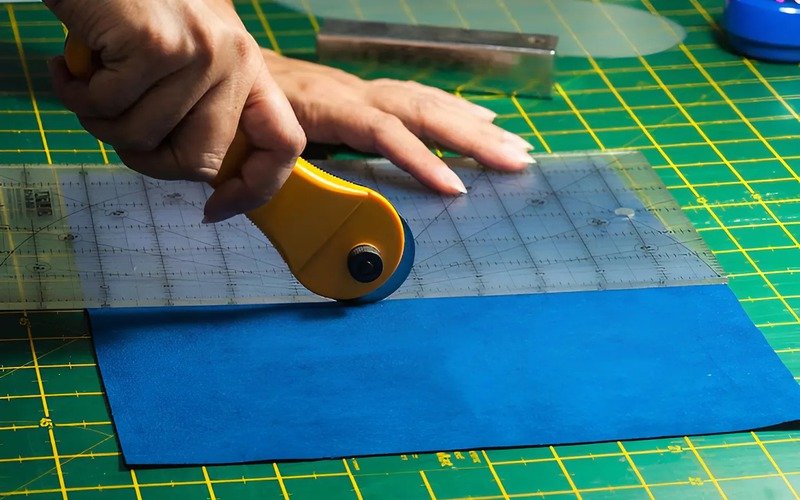
3. The magic of self-healing: how do cutting mats work?
‘Self-healing’ is a special feature you’ll often hear about with cutting mats. It sounds a bit like magic! It means that when you make a light cut on the mat with a sharp knife, the tiny cut mark seems to close up. The surface tries to return to being smooth.
It’s important to know it doesn’t mean the mat is impossible to damage. Very big, deep cuts will not disappear completely. But for many small, everyday cuts, they become much less noticeable. This helps the surface stay smoother for a much longer time.
It’s not actual magic, but clever materials science. Most self-healing cutting mats are made of several layers of special soft, yet durable, plastic materials. Often, this is a type of PVC (Polyvinyl Chloride – a type of plastic commonly used for cutting mats). Think of it like this: the mat has a firm inner core layer for strength. It has softer outer layers on both sides where you cut.
When your sharp blade makes a cut, it gently parts the particles of this soft material. Because the material is soft but also ‘springy’, these tiny particles try to move back. They press back together. This makes the cut mark less obvious. It helps the surface feel smooth again. It’s like pressing your finger into firm jelly. It leaves a temporary mark, but the material returns to its shape.
This feature is very popular for most crafts. Firstly, because the mat ‘heals’, its surface stays smoother for longer. Your knife blade won’t get caught in old, deep cut grooves. Secondly, a smoother surface means your new cuts are more likely to be straight and clean. Finally, the mat itself lasts longer. It can recover from many small cuts. This gives you better value for your money. That’s why most crafters and sewers prefer self-healing mats.
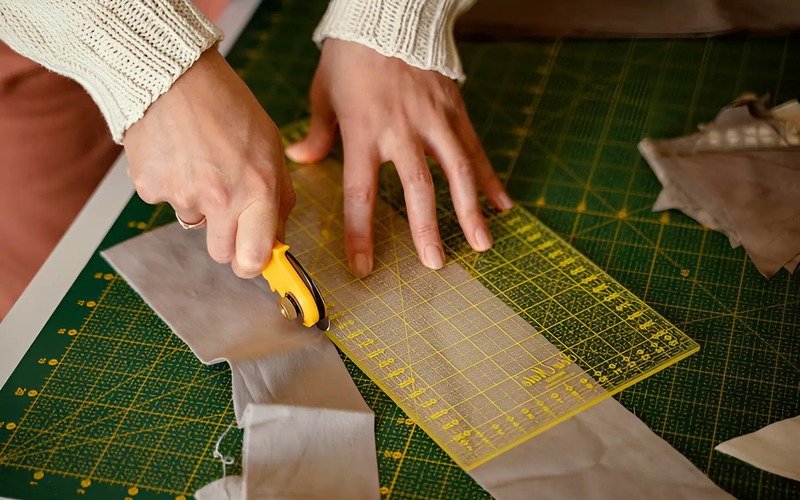
4. Types of cutting mats: finding your perfect match
4.1. Self-healing cutting mats: the all-rounder
These popular mats are usually made from special plastic compounds, like PVC. They often have a multi-layer construction. A hard inner core layer gives stiffness. Softer outer layers on each side are for cutting and ‘healing’.
Self-healing mats are fantastic all-rounders. They are good for many crafts. This includes cutting paper for card making or scrapbooking. It includes cutting fabric for sewing and quilting. It is good for detailed work in model making. If you are starting out, a self-healing mat is usually the best choice.
Besides the self-healing surface, these mats usually have printed grid lines for measuring. Many also include lines for cutting common angles. A big plus is that many are double-sided. You can use both surfaces. This extends their life. Sometimes each side has different colored grids.
4.2. Non-self-healing mats (e.g., hard plastic, cardboard)
These mats are made from materials that don’t ‘heal’. This could be hard plastic or thick cardboard. They are best for very heavy-duty cutting. This is when you don’t mind if the surface gets marked up quickly. They can be a cheap, basic protective layer for occasional cutting.
- Pros: usually cheaper. Can be very stiff.
- Cons: every cut mark stays. Marks can make your knife slip. Blades get dull faster. The surface becomes rough. They don’t last as long for regular crafting. These are not ideal for fine crafting or frequent use.

4.3. Glass cutting mats
Glass cutting mats are made from special tempered glass (safety glass that is toughened to be more resistant to breakage). This glass is strong.
They are excellent for cutting with craft knives. They are good for extreme precision and a super smooth surface. Artists love them for working with paints, inks, or glue. The glass surface is easy to clean. Clear glass mats can be used on a lightbox (a flat box with a light inside, used for tracing).
- Pros: incredibly smooth and flat. Surface won’t get cut. Very easy to clean. Good for precise measurements if gridded.
- Cons: not self-healing, so blades can dull faster than on PVC mats. Can break if dropped. Usually more expensive. Light can reflect off the surface.
4.4. Rotating cutting mats
A rotating cutting mat is usually a smaller self-healing mat. It sits on a separate base. The top cutting mat part spins smoothly. These are popular with quilters who make intricate blocks. They are helpful for cutting tricky shapes or curves. You can turn the mat easily instead of moving your material or yourself. This makes it easier to get the right cutting angle.
- Pros: easier to cut complex shapes and curves. Saves time and reduces strain. Can improve accuracy.
- Cons: cutting area is usually smaller. Might not feel as stable as a large mat. An additional cost.
4.5. Translucent cutting mats
Translucent cutting mats are made from clear or semi-clear plastic. They are often self-healing too. You can see light through them. Their main use is with a lightbox. This is great for tracing patterns or designs. Calligraphers and illustrators find them useful.
4.6. Specialty mats (e.g., magnetic, foldable)
- Magnetic mats: some mats have a magnetic surface. These are useful if you work with small metal rulers or thin metal cutting guides called dies (in die-cutting: thin metal shapes used to cut paper or other materials). They help hold them in place.
- Foldable mats: foldable cutting mats can be folded up. This makes them easier to carry or store. These are ideal for crafters with limited storage space or who need to transport their mats frequently.
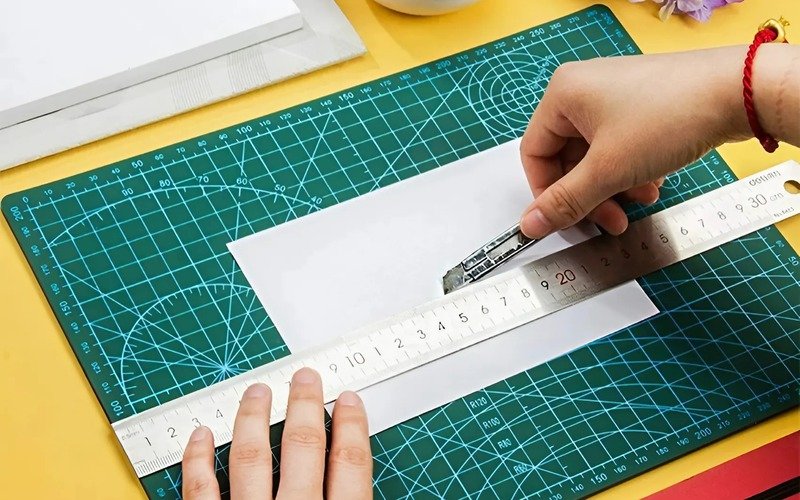
5. Key features to look for when buying a cutting mat
5.1. Size: how big should your mat be?
Cutting mats come in many sizes. You’ll see them described by paper sizes like A4, A3, A2, and A1. Other common sizes are 12×18 inches, 18×24 inches, and 24×36 inches.
How to choose:
- Think about your project size. Small cards need a smaller mat. Large fabric pieces need a bigger mat.
- Consider your workspace. Make sure the mat fits.
- It’s advisable to choose a mat that is slightly larger than the largest items you typically work with.
5.2. Gridlines and markings: your guide to precision
Some mats have measurements in inches. Some have centimeters. Some have both. Choose the system you prefer. Many mats feature printed lines for angles like 30°, 45°, and 60°. These are helpful for cutting shapes accurately.
Clear gridlines and angle markings are vital. They help you line up materials precisely. They ensure cuts are straight. They allow measuring directly on the mat. Good markings help achieve professional results.
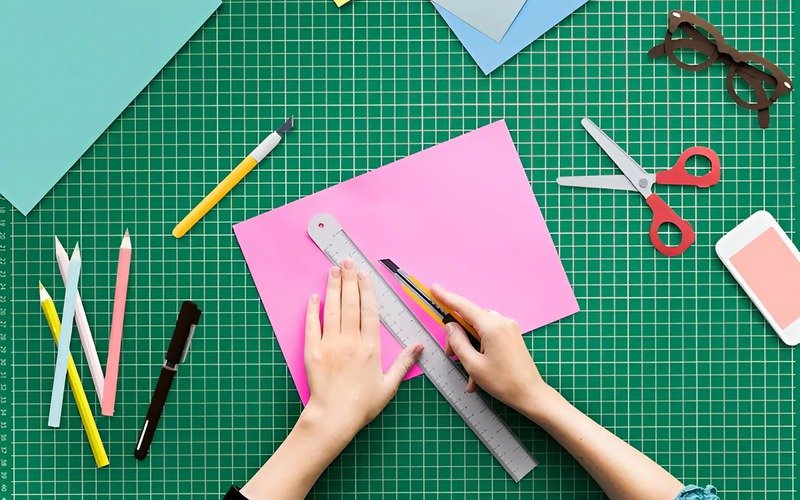
5.3. Material & thickness: durability and function
Self-healing mats are usually layered PVC. Glass mats are tempered glass. Material choice matters for your type of work. Self-healing mats come in different thicknesses. Around 3mm is standard. Heavy-duty mats can be 5mm. Generally, a thicker mat is more durable. It is less likely to warp or be cut through. Thicker mats often have better self-healing performance.
5.4. Single-sided vs. double-sided mats
Many self-healing mats are double-sided. You can use both surfaces. This is a great feature. One side might have inches, the other centimeters. Or they might have different colored grids. Using both sides effectively doubles the mat’s lifespan.
5.5. Color: does it matter?
Cutting mats come in various colors. Green is common. You can also find blue, pink, black, or clear. Functionally, color provides contrast with materials. For light materials, a darker mat is easier to see. For dark materials, a lighter mat could be better. Mostly, color choice is personal preference.
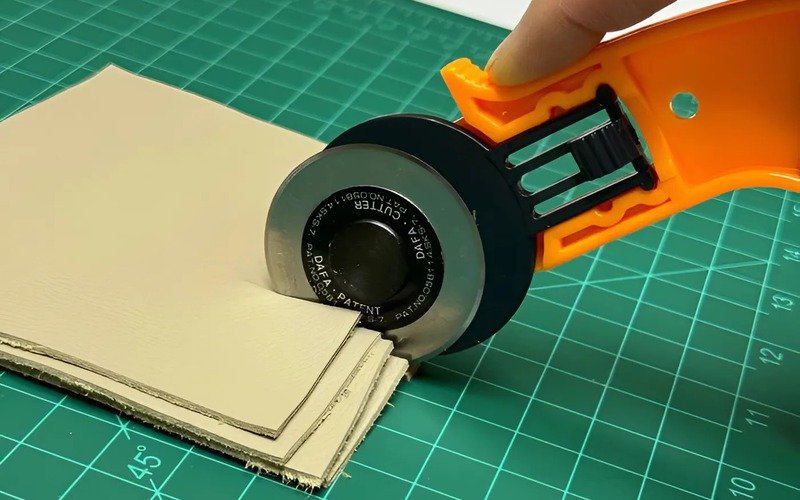
6. How to choose the right cutting mat for you
6.1. For paper crafters & card makers
A self-healing cutting mat is best for paper crafts. Common sizes include A4, A3 (about 12×18 inches), or a 12×12 inch square mat. An A3 mat often provides a good balance. Look for clear grid lines and angle lines. People making handmade cards need precise cuts for a professional finish.
6.2. For sewers & quilters
A large self-healing cutting mat is essential for sewers or quilters. Ensure the mat is suitable for rotary cutters. An 18×24 inch mat is a good start. Many quilters prefer a 24×36 inch mat. Clear, precise grid lines are a must. Lines for 30, 45, and 60-degree angles are very important. A smaller rotating cutting mat can be a helpful addition.
6.3. For model makers & general hobbyists
A self-healing cutting mat is highly recommended for model making. An A4 or A3 size mat is often a good start. A good quality self-healing surface is important for small, careful cuts. If you cut thicker materials, consider a thicker mat (e.g., 5mm).
6.4. For graphic designers or artists
A glass cutting mat can be excellent if you use inks, paints, or glues. It’s easy to clean and very smooth. For general cutting, a high-quality self-healing mat is also very good. An A3 size or larger is often preferred. If you choose glass for tracing, ensure it’s clear. For a self-healing mat, look for an accurate, fine grid.
6.5. Budget considerations.
Good quality self-healing mats offer the best value for most crafters. Non-self-healing mats are cheaper upfront but may need replacing sooner. Glass cutting mats tend to be more expensive. Think of a cutting mat as an investment in your hobby. A good mat can improve your results.
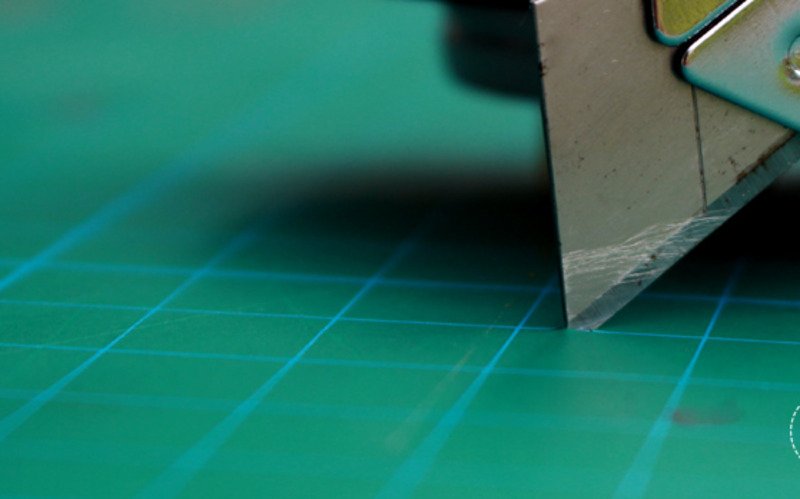
7. Getting started: how to use your cutting mat correctly
7.1. Tools to use with your mat (rotary cutters, craft knives/X-Acto knives).
The main cutting tools are rotary cutters and craft knives. Rotary cutters have a round, rolling blade. They are excellent for cutting fabric and long straight lines. Craft knives (like X-Acto knives – a brand name for a type of craft knife) have small, pointed blades.
They are great for paper, cardstock, and detailed shapes. Always use a sturdy metal ruler with these tools. Avoid plastic rulers for cutting, as blades can easily damage them or slip.
7.2. Basic cutting technique
- Proper knife grip and pressure: hold a craft knife like a pen. Your grip should be firm but relaxed. Apply steady, even pressure. Two or three lighter passes are often better than one forceful cut.
- Standing vs. sitting: for long, straight cuts, standing often gives a better view and more control. For small, detailed work, sitting is usually fine.
- Using rulers for straight cuts: always use a ruler for straight cuts. A metal ruler is best. Place the ruler along your cutting line. Hold the ruler down firmly with one hand. Keep your fingers away from the blade’s path. Draw your knife or push your rotary cutter along the ruler’s edge. These techniques lead to cleaner cuts and better safety.
7.3. Common mistakes to avoid.
- Using dull blades: using dull blades can tear or snag your material, leading to messy cuts. Change blades regularly.
- Always cutting in the exact same spot: vary where you cut on the mat.
- Using too much force: a sharp blade doesn’t need extreme pressure.
- Using your mat for things other than cutting: avoid hot drinks or hammering on it.
- Trying to cut long straight lines ‘freehand’: always use a ruler.
- Cutting towards yourself: always try to cut away from your body.
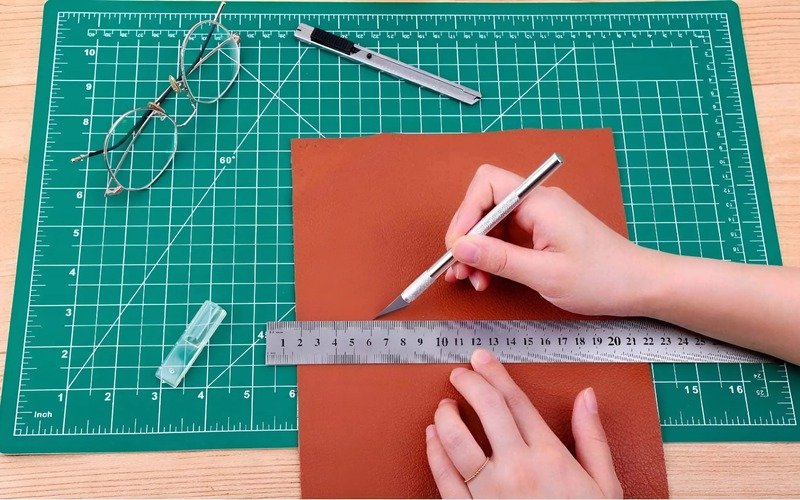
8. Love your mat: care and maintenance tips
8.1. How to clean your cutting mat
Removing lint, paper fibers, adhesive:
- Use a lint roller or wide sticky tape for loose dust and fibers.
- An artist’s gum eraser can lift bits out of shallow cuts.
- For sticky residue, try a specialized adhesive remover (test on a corner first). Rubbing alcohol can work sparingly.
Gentle cleaning methods:
- Wipe with a soft cloth dampened with cool water.
- Use a tiny drop of mild soap if needed. Rinse well.
- Don’t use strong chemical cleaners or abrasive scrubbers.
- Avoid soaking the mat. Gentle cleaning preserves the self-healing properties.
8.2. Storing your mat properly
- Keep it flat! always keep it flat! store it flat on a large shelf or under a bed. If hanging, ensure it hangs completely straight.
- Away from direct sunlight and heat: do not leave your mat in direct sunlight or near heat sources. Heat can cause warping. Avoid rolling or folding standard mats. Proper storage prevents warping. Warping makes the mat hard to use.
8.3. Extending its lifespan
- Rotate your mat: turn it around regularly.
- Vary your cutting areas: distribute cuts over the entire surface.
- Use both sides: flip it over periodically if it’s double-sided.
- Use sharp blades: sharp blades require less pressure.
- Clean it regularly: debris can interfere with self-healing.
8.4. What to do if your mat warps
Prevention is best. If your mat has a slight warp, try this (no guarantees):
- Lay the mat on a completely flat surface in a warm room. Avoid direct sunlight.
- Place heavy, flat, evenly distributed weights (like large books) all over it.
- Leave it for at least 24-48 hours.
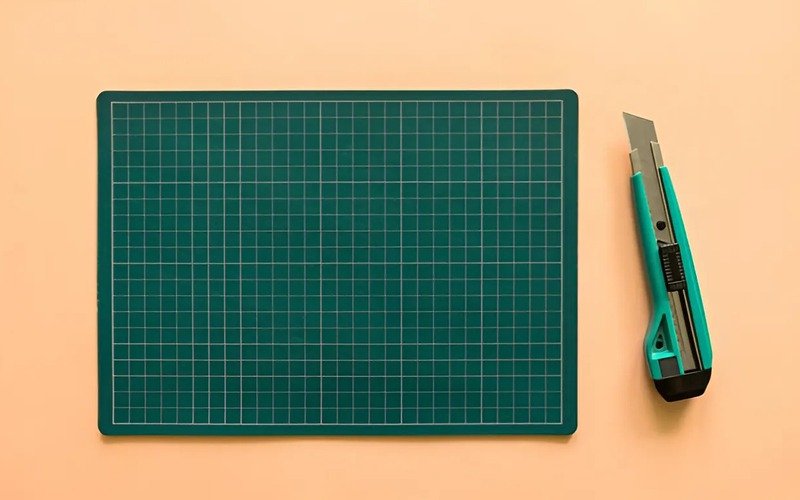
9. Cutting mats: precision for projects worth showcasing
A good cutting mat helps your cuts become cleaner. Your edges are straighter. Your measurements are more exact. These details make handmade items look more polished and professional. A cutting mat is key to achieving that finish.
If you cut project components perfectly, it shows you value quality. This attention to detail extends to presentation. You’ll want packaging, labels, and tags to look neat. A cutting mat is invaluable for creating these touches. Think perfectly cut custom hang tags.
Buying a good quality cutting mat is an investment in your craft. Good tools help improve skills and create higher-quality items. When your creations are made with care, they deserve to be packaged with love. Showcase your quality crafts with packaging that reflects your care.
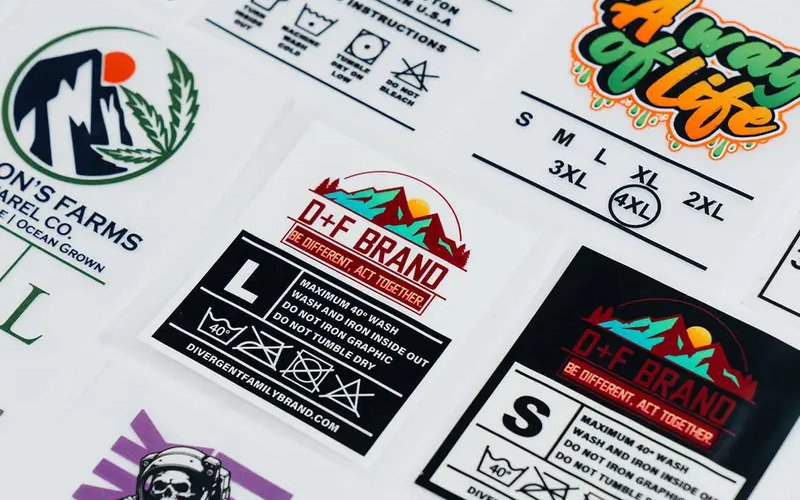
10. Frequently asked questions (FAQs)
10.1. Are all cutting mats self-healing?
No, not all cutting mats are self-healing. Self-healing is a popular feature in mats made from layered PVC. Other types, like hard plastic or glass mats, do not ‘self-heal’.
10.2. Can I use any knife on a cutting mat?
Mostly, yes. Standard cutting mats work well with craft knives and rotary cutters. Glass mats can dull blades faster than PVC self-healing mats. Always use a sharp blade. Avoid very heavy-duty utility knives.
10.3. What’s the best size cutting mat for a beginner?
An A3 size mat (roughly 12×18 inches) is good for many beginners. It handles common projects but isn’t too large. Think about your project types to choose a comfortable size.
10.4. My cutting mat is warped, can I fix it?
Maybe, if warping isn’t severe. Prevention is best: store it flat and away from heat. For a slight warp, try laying it flat in a warm room with heavy, flat items on top for a day or two. See our ‘care and maintenance’ section for more details. This is not a guaranteed fix.
10.5. How often should I replace my cutting mat?
It depends on use frequency, mat type, materials cut, and care. A well-maintained self-healing mat can last years. Replace it when the surface is very rough, has deep cuts, or affects cut quality.
Read more:
A cutting mat is an essential tool for almost any crafter. It protects your table. It helps blades stay sharp. It makes cuts accurate. It provides a stable surface. It helps you work safely. We hope this guide helps you choose the perfect cutting mat.
Using the right tools makes crafting more enjoyable. Your finished projects will look even better. Ready to take your crafting to the next level? Need more tips and inspiration? Explore more helpful guides and articles on the Packlove website






















